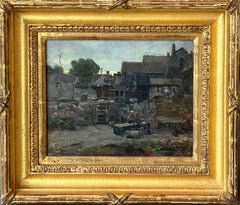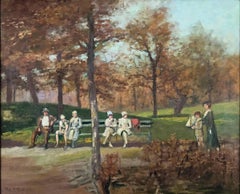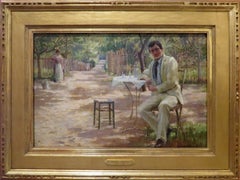Paul Cornoyer Art
American, 1864-1923
Paul Cornoyer was born in 1864 in St. Louis, Missouri. He studied there at the School of Fine Arts in 1881. His first works were in a Barbizon mode, and his first exhibit was in 1887. In 1889, he went to Paris for further training, studying at the Academie Julien, and returned to St. Louis in 1894.
By the early 1890s, his work was more lyrical and Tonal, and he applied this style to subjects such as cityscapes and landscapes. In 1894, he painted a mural depicting the birth of St. Louis for the Planters Hotel in that city. His activities during the next six years were not particularly profitable, however, and the whereabouts of his St. Louis paintings are scarcely known. One exception is the triptych, A View of Saint Louis, with its strong urban realism. It shows the Eads Bridge, which opened in 1874, and became the symbol of Saint Louiss urban modernity, a gateway to the West, and a marvel of engineering. Many other St. Louis artists also celebrated its construction.
In 1899, Cornoyer traveled to New York City, upon the encouragement of William Merritt Chase, who had acquired some of his work (probably the Parisian scene shown at the Pennsylvania Academy of the Fine Arts annual in 1896-97).
In New York, Cornoyer became a specialist in Tonal urban scenes, especially after rain with its blurred effects, his masterwork being The Plaza after Rain, purchased in 1910 by the new art museum of St. Louis. He was able to capture the wet, mirrored pavements with precision, streets with horse drawn carriages, trees, aligned buildings and streets.
In addition, Cornoyer taught at the Mechanics Institute in New York, and later was an instructor in Massachusetts, moving there in 1917. He painted and exhibited his works up until his death in 1923.(Biography provided by Gallery of the Masters)
to
5
4
5
1
1
1
2
Overall Height
to
Overall Width
to
3
1
4
3
2
1
1
1
1
5
1
1
5
6,961
3,321
2,514
1,213
5
5
3
3
Artist: Paul Cornoyer
American Impressionist Paul Cornoyer, "Bearksin Neck, Rockport"
By Paul Cornoyer
Located in Rockport, MA
Paul Cornoyer, born in 1864 in St. Louis, Missouri, was an American Impressionist artist. Initially studying at the St. Louis School of Fine Arts under Halsey C. Ives, he began his artistic journey painting in a style reminiscent of the Barbizon School. His first exhibition took place in 1887, followed by further studies in Paris at the Académie Julian under notable instructors such as Jules Lefebre, Louis Blanc, and Benjamin Constant. Inspired by French Impressionism during his travels to Paris, London, and Venice, Cornoyer embraced a more fluid and tonal style, particularly evident in his landscapes and cityscapes.
Returning to St. Louis in 1894, he painted a mural at the Planters Hotel, depicting the city's birth. Over the next six years, little is known about his work except for the creation of a significant triptych titled "A View of St. Louis," which became iconic for the city.
Encouraged by the artist William Merritt Chase, Cornoyer moved to New York City in 1899, where he gained recognition for his urban cityscapes, particularly scenes after rainfall. Capturing the essence of city life with vivid depictions of streets, carriages, and towering buildings, Cornoyer's work became synonymous with New York's urban landscape. He also taught at the Mechanics Institute and mingled with prominent artists such as Childe Hassam and J. Alden Weir, expanding his artistic circle to include New England art schools.
In 1917, Cornoyer relocated permanently to Massachusetts, establishing his studio in East Gloucester. He played a pivotal role in founding the Gloucester Art...
Category
20th Century American Impressionist Paul Cornoyer Art
Materials
Oil
Chelsea
By Paul Cornoyer
Located in New York, NY
“Chelsea” by Paul Cornoyer sees the artist depict a busy street in the Chelsea neighborhood of Manhattan, with cars moving underneath an overpass.
Category
Early 20th Century Modern Paul Cornoyer Art
Materials
Canvas, Oil
Madison Square Garden at Night
By Paul Cornoyer
Located in New York, NY
Signed and dated lower left: PAUL CORNOYER / 1912
Category
20th Century American Impressionist Paul Cornoyer Art
Materials
Oil
Afternoon, Madison Square
By Paul Cornoyer
Located in Missouri, MO
Paul Cornoyer (American, 1864-1923)
"Afternoon, Madison Square" (New York City) 1908
Oil on Canvas
Signed/Titled Verso on Stretcher Bar
Unframed: 22 x 27 inches
Framed: 32.5 x 38 inches
Exhibition Label Verso (Presumably Newhouse Galleries, St. Louis...
Category
Early 1900s Tonalist Paul Cornoyer Art
Materials
Oil, Canvas
Central Park Autumn
By Paul Cornoyer
Located in Missouri, MO
Paul Cornoyer
“Central Park Autumn” c. 1910
Oil on Canvas
Framed Size: approx 29 x 35 inches
Canvas Size: approx 22 x 26.5 inches
Provenance: The Artist to Private Collection, St. Louis thence by Descent
Conservation report: Excellent condition. On original canvas, not relined. No in-painting.
Paul Cornoyer was born in 1864 in St. Louis, Missouri. He studied there at the School of Fine Arts in 1881. His first works were in a Barbizon mode, and his first exhibit was in 1887. In 1889, he went to Paris for further training, studying at the Academie Julien, and returned to St. Louis in 1894.
By the early 1890s, his work was more lyrical and Tonal, and he applied this style to subjects such as cityscapes and landscapes. In 1894, he painted a mural depicting the birth of St. Louis for the Planters Hotel in that city. His activities during the next six years were not particularly profitable, however, and the whereabouts of his St. Louis paintings are scarcely known. One exception is the triptych, A View of Saint Louis, with its strong urban realism. It shows the Eads Bridge...
Category
1910s American Impressionist Paul Cornoyer Art
Materials
Oil, Canvas
Related Items
While The Tide is Out, Provincetown
By Alexis Jean Fournier
Located in Milford, NH
A fine impressionist painting on the shore of Cape Cod with cottages, boats, and figures by American artist Alexis Jean Fournier (1865-1948). Fournier was born on the fourth of July ...
Category
Early 20th Century American Impressionist Paul Cornoyer Art
Materials
Oil, Canvas
"The Gentleman"
By Carle John Blenner
Located in Lambertville, NJ
Ashley John is proud to offer this artwork by:
Carle Blenner (1862 - 1952)
Carle Blenner was born in Richmond, Virginia, and received his education in Marburg, Germany. Blenner re...
Category
Early 20th Century Impressionist Paul Cornoyer Art
Materials
Oil, Canvas
Untitled (Farm in Winter)
By Julius M. Delbos
Located in Los Angeles, CA
This work is part of our exhibition America Coast to Coast: Artists of the 1940s
Untitled (Farm in Winter), 1940s, oil on canvas, signed lower right, 26 x 30 inches, presented in an original frame
Julius Delbos...
Category
1940s American Modern Paul Cornoyer Art
Materials
Canvas, Oil
Christ Carrying the Cross, Old Master, Flemish, De Vos, Religious Scene, Rubens
By Simon de Vos
Located in Greven, DE
The scene of Christ carrying the cross is imagined in a rocky landscape. Two soldiers press the cross onto his shoulders, another leads him, holding the rope. A line of soldiers and prisoners moves from right to left. In front of them the three Marys kneel and pray for Christ. A nursing woman, symbol of Caritas, sits in the right foreground. Some dogs and playing kids enliven the scenery.
Simon de Vos was born in Antwerp, and was first taught by Cornelis de Vos...
Category
17th Century Baroque Paul Cornoyer Art
Materials
Canvas, Oil
Free Shipping
H 23.04 in W 33.27 in
Cattle By Pond At Dusk, Mid-19th Century Tonalist Landscape by William Keith
By William Keith
Located in Soquel, CA
Cattle By Pond At Dusk, Mid-19th Century Tonalist Landscape by William Keith
Gorgeous mid-19th century landscape painting by William Keith (American, 1838-1911), circa 1860. This impressive Tonalist landscape, titled "In the Woods", depicts cattle beside a pond in the forest at dusk. Keith uses loose, blended brush strokes and a muted earthy palette to create an atmospheric mood that Tonalism is known for.
Signed "W. Keith" lower left.
Museum label on verso from Santa Barbara Museum of Art.
Presented in an antique giltwood frame.
Image size: 9"H x 13"W. With frame measures: 16"H x 20"W x 3"D.
Provenance:
Mrs. Eugene Patterson; Santa Barbara Museum of Art.
Authenticity guaranteed and certificate include.
Condition:
Very good. Cleaning and restoration required signature to be re-touched, original images pre-restoration available.
About the Artist:
Brought to New York City in 1850, William Keith was apprenticed to a wood engraver in 1856 working for "Harper's" magazine. In 1858 (or 1859) he visited California for "Harper's" and then after a trip to Great Britain, settled in California as an engraver in 1862. He began exhibiting paintings in 1864 in San Francisco where he opened his studio, after having been taught painting by his wife.
The Northern Pacific Railroad...
Category
Late 19th Century Tonalist Paul Cornoyer Art
Materials
Cardboard, Oil
H 16.25 in W 21.5 in D 3 in
At the Clothesline
By Irving Ramsey Wiles
Located in New York, NY
Signed lower right: Irving R. Wiles
Category
Late 19th Century American Impressionist Paul Cornoyer Art
Materials
Canvas, Oil
Tonalist Painting Sunset Figures Wheat Barbizon Framed 19th Century Oil Painting
Located in Buffalo, NY
An antique oil painting in its original ornate gold leaf frame.
This tonalist painting depicts figures against a dramatic sunset.
The work is signed illegibly lower left. It ap...
Category
1860s Tonalist Paul Cornoyer Art
Materials
Oil, Canvas
Winter Moonlight
By George William Sotter
Located in Lambertville, NJ
signed lower right
Category
1910s American Impressionist Paul Cornoyer Art
Materials
Canvas, Oil
Carmel Valley Gardener Landscape
By Ray Barton
Located in Soquel, CA
Painting of a Carmel Valley Gardener by Ray Barton (American, 1918-1988). Ray Barton specialized in plein air paintings of Carmel Valley and Pacific Grov...
Category
1980s American Impressionist Paul Cornoyer Art
Materials
Canvas, Oil
Union Square, Winter (Washington Monument)
By Theodore Robinson
Located in New York, NY
As one of the first, and most important, American Impressionists, Theodore Robinson helped to introduce the French style to American artists and audiences.
Category
19th Century American Impressionist Paul Cornoyer Art
Materials
Oil
"Up the Valley"
By Daniel Garber
Located in Lambertville, NJ
In an original Harer frame.
Illustrated in "Daniel Garber Catalogue Raisonne" Vol. II, pg. 271, and in book titled "Blue Chips", pg. 33
Jim’s of Lambertville is proud to offer this artwork by:
Daniel Garber (1880-1958)
One of the two most important and, so far, the most valuable of the New Hope School Painters, Daniel Garber was born on April 11, 1880, in North Manchester, Indiana. At the age of seventeen, he studied at the Art Academy of Cincinnati with Vincent Nowottny. Moving to Philadelphia in 1899, he first attended classes at the "Darby School," near Fort Washington; a summer school run by Academy instructors Anshutz and Breckenridge. Later that year, he enrolled at the Pennsylvania Academy of the Fine Arts. His instructors at the Academy included Thomas Anshutz, William Merritt Chase and Cecilia Beaux. There Garber met fellow artist Mary Franklin while she was posing as a model for the portrait class of Hugh Breckenridge. After a two year courtship, Garber married Mary Franklin on June 21, 1901.
In May 1905, Garber was awarded the William Emlen Cresson Scholarship from the Pennsylvania Academy, which enabled him to spend two years for independent studies in England, Italy and France. He painted frequently while in Europe, creating a powerful body of colorful impressionist landscapes depicting various rural villages and farms scenes; exhibiting several of these works in the Paris Salon.
Upon his return, Garber began to teach Life and Antique Drawing classes at the Philadelphia School of Design for Women in 1907. In the summer of that same year, Garber and family settled in Lumbertville, Pennsylvania, a small town just north of New Hope. Their new home would come to be known as the "Cuttalossa," named after the creek which occupied part of the land. The family would divide the year, living six months in Philadelphia at the Green Street townhouse while he taught, and the rest of the time in Lambertville. Soon Garber’s career would take off as he began to receive a multitude of prestigious awards for his masterful Pennsylvania landscapes. During the fall of 1909, he was offered a position to teach at the Pennsylvania Academy as an assistant to Thomas Anshutz. Garber became an important instructor at the Academy, where he taught for forty-one years.
Daniel Garber painted masterful landscapes depicting the Pennsylvania and New Jersey countryside surrounding New Hope. Unlike his contemporary, Edward Redfield, Garber painted with a delicate technique using a thin application of paint. His paintings are filled with color and light projecting a feeling of endless depth. Although Like Redfield, Garber painted large exhibition size canvases with the intent of winning medals, and was extremely successful doing so, he was also very adept at painting small gem like paintings. He was also a fine draftsman creating a relatively large body of works on paper, mostly in charcoal, and a rare few works in pastel. Another of Garber’s many talents was etching. He created a series of approximately fifty different scenes, most of which are run in editions of fifty or less etchings per plate.
Throughout his distinguished career, Daniel Garber was awarded some of the highest honors bestowed upon an American artist. Some of his accolades include the First Hallgarten Prize from the National Academy in 1909, the Bronze Medal at the International Exposition in Buenos Aires in 1910, the Walter Lippincott Prize from the Pennsylvania Academy and the Potter Gold Medal at the Art Institute of Chicago in 1911, the Second Clark Prize and the Silver Medal from the Corcoran Gallery of Art for “Wilderness” in 1912, the Gold Medal from the Panama-Pacific Exposition in San Francisco of 1915, the Second Altman Prize in1915, the Shaw prize in 1916, the First Altman Prize in 1917, the Edward Stotesbury Prize in1918, the Temple Gold Medal, in 1919, the First William A...
Category
1940s American Impressionist Paul Cornoyer Art
Materials
Oil, Panel
Miner Hillard Milling Company
By George William Sotter
Located in New York, NY
Signed lower right: G.W. Sotter; on verso: MINER HILLARD / MILLING Co.
Category
Mid-20th Century American Impressionist Paul Cornoyer Art
Materials
Oil, Board
Paul Cornoyer art for sale on 1stDibs.
Find a wide variety of authentic Paul Cornoyer art available for sale on 1stDibs. You can also browse by medium to find art by Paul Cornoyer in oil paint, paint, canvas and more. Much of the original work by this artist or collective was created during the 20th century and is mostly associated with the Impressionist style. Not every interior allows for large Paul Cornoyer art, so small editions measuring 20 inches across are available. Customers who are interested in this artist might also find the work of Wilson Henry Irvine, Frank Vincent Dumond, and William Lester Stevens. Paul Cornoyer art prices can differ depending upon medium, time period and other attributes. On 1stDibs, the price for these items starts at $35,000 and tops out at $125,000, while the average work can sell for $47,500.




